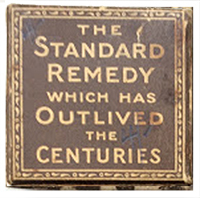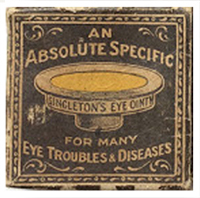Singleton's Golden Eye Ointment pedestal
Dublin Core
Title
Identifier
Description
Ceramic pedestal pot for Singleton's Golden Eye Ointment, with blue printed lettering:
'SINGLETON'S GOLDEN EYE OINTMENT'
Creator
Subject
Medicine;
Ceramics.
Date
Source
Publisher
Contributor
Singleton’s Golden Eye Ointment claimed to be a cure for all eye disorders, including sore eyes, styes, ulcers, inflammation, weak eyes and watery eyes, as well as being able to restore eyelashes.
The eye ointment was placed on top of the pedestal and was covered with a wax paper seal to preserve it. The ointment was an orange colour and contained quicksilver, which is the heavy metal mercury. Liquid mercury was heated with nitric acid and then evaporated, with the resulting salt being mixed with clarified butter to make the ointment. Singleton recommended rubbing the ointment on the eyelids at night and then bathing the eyes with warm water on rising. In high enough doses, mercury causes kidney failure.
The ointment became particularly popular after it was widely used by the British army during the Napoleonic campaign in Egypt in 1798-1800, when large numbers of soldiers suffered eye damage from the hot desert sand. The porcelain pedestal came in a small cardboard box and sold for a premium price of 2s/9d.


Examples of the type of packaging these ceramic jars came in.
This product originated in England in 1596 as 'Dr Johnson's Golden Eye Ointment' and the recipe was subsequently passed to the Hind family.
William Hind gave the ointment recipe to his daughter, Selina, in 1794, as a wedding present when she married Thomas Singleton.
Selina bequeathed the ointment to her children when she died in 1816. Her eldest son, William, ran the business until his death in 1825, when the recipe passed to his younger sister Selina. It was during this time that the porcelain pedestal pots were first produced (1804).
Selina married Thomas Green, who became the sole proprietor of the ointment in 1848 after her death. During the 1860s and 1870s the porcelain ointment pots were manufactured by Mid-Lothian Pottery Co., Portobello, Edinburgh.
Format
Diagnostic: Yes
Diameter: 53 mm
Height: 20 mm
Foot diameter: 18 mm
Weight: 50 g
Type
Coverage
Old Smithfield township, Barron QLD 4871
Colonial Queensland
1870s
Rights
Geolocation
Collection
Citation (Chicago 17 Style)
Item Relations
This item has no relations.


